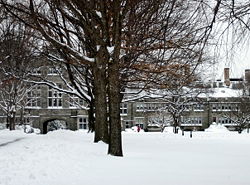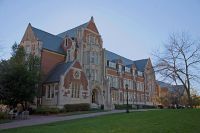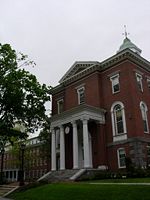Liberal arts college
Liberal arts colleges are primarily colleges with an emphasis upon undergraduate study in the liberal arts. The Encyclopædia Britannica Concise offers the following definition of the liberal arts as a, "college or university curriculum aimed at imparting general knowledge and developing general intellectual capacities, in contrast to a professional, vocational, or technical curriculum." [1] Although the genesis for what is known today as the liberal arts college began in Europe, [2] the term is commonly associated with the United States. Liberal arts colleges are found in countries all over the world as well.
Lists of schools
See also
- Liberal arts
- Liberal arts colleges in the United States
External links
- Philosophy of Liberal Education
- Liberal Arts at the Community College
- A Descriptive Analysis of the Community College Liberal Arts Curriculum
- The Center of Inquiry in the Liberal Arts
- Academic Commons
- CatholiCity: Catholic Encyclopedia
Further reading
- Harriman, Philip. "Antecedents of the Liberal Arts College." The Journal of Higher Education. Vol. 6, No. 2 (1935): 63-71.
- Pfnister, Allen O. "The Role of the Liberal Arts College." The Journal of Higher Education. Vol. 55, No. 2 (March/April 1984): 145-170.
- Reeves, Floyd W. "The Liberal-Arts College." The Journal of Higher Education. Vol. 1, No. 7 (1930): 373-380.
- Seidel, George. "Saving the Small College." The Journal of Higher Education. Vol. 39, No. 6 (1968): 339-342.
Notes
- ↑ Liberal Arts: Encyclopedia Britannica Concise. Encyclopedia Britannica.
- ↑ Harriman, Philip (1935). Antecedents of the Liberal Arts College. The Journal of Higher Education.
Template:US-university-stub
Liberal arts colleges in the United States are institutions of higher education in the United States. The Encyclopædia Britannica Concise offers the following definition of the liberal arts as a, "college or university curriculum aimed at imparting general knowledge and developing general intellectual capacities, in contrast to a professional, vocational, or technical curriculum." [1] Generally, a full-time, four-year course of study at a liberal arts college leads students to a Bachelor of Arts or Bachelor of Science degree.
Overview
These schools are American institutions of higher education which have traditionally emphasized interactive instruction (although research is still a component of these institutions). They are known for being residential and for having smaller enrollment, class size, and teacher-student ratios than universities. These colleges also encourage a high level of teacher-student interaction at the center of which are classes taught by full-time faculty rather than graduate student TAs (who teach some of the classes at Research I and other universities). The colleges are either coeducational, women's colleges, or men's colleges. Some are historically black colleges. Some are also secular (or not affiliated with a particular religion) while others are involved in religious education. Many are private. Some are public liberal arts colleges. In addition, colleges such as Hampshire College, Beloit College, Pitzer College, Sarah Lawrence College, Bennington College, New College of Florida and Reed College offer experimental curricula.
Consortia and groups
Liberal arts colleges are also often associated with larger groups or consortia. In the United States, many liberal arts colleges belong to the Annapolis Group, Oberlin Group, Women's College Coalition, and the Consortium of Liberal Arts Colleges. The Council of Public Liberal Arts Colleges is a consortium of public liberal arts colleges. A number of liberal arts colleges are involved in Project Pericles or the Eco League.
Regional
Well-known consortia in the Eastern United States include the Little Ivies, Little Three, and the Seven Sisters Colleges. Four Eastern colleges, along with the University of Massachusetts Amherst, are also part of the Five Colleges Consortium in Western Massachusetts and three Eastern colleges comprise the Tri-College Consortium.
Similar consortia include the Claremont College Consortium in Southern California and the Associated Colleges of the Midwest in the Midwestern United States.
Additional midwestern groups include the Five Colleges of Ohio, Associated Colleges of the Twin Cities, and the Great Lakes Colleges Association.
Groups in the Southern United States include the Associated Colleges of the South, and the Seven Sisters of the South.
Purpose and goals
Chapter One ("The Liberal Arts: What is a Liberal Arts Education and Why is it Important Today") of Howard Greene and Matthew Greene's, Hidden Ivies: Thirty Colleges of Excellence, defines the goals of a liberal arts education in the following manner:
- In a complex, shifting world, it is essential to develop a high degree of intellectual literacy and critical-thinking skills, a sense of moral and ethical responsibility to one's community, the ability to reason clearly, to think rationally, to analyze information intelligently, to respond to people in a compassionate and fair way, to continue learning new information and concepts over a lifetime, to appreciate and gain pleasure from the beauty of the arts and literature and to use these as an inspiration and a solace when needed, to revert to our historical past for lessons that will help shape the future intelligently and avoid unnecessary mistakes, to create a sense of self-esteem that comes from personal accomplishments and challenges met with success. [2]
In addition, college placement counselor, Loren Pope, suggests that at the liberal arts colleges he lists in Colleges That Change Lives,
- the focus is on the student, not the faculty; he is heavily involved in his own education. There are no passive ears; students and faculty work so closely together, they even coauthor publications. Teaching is an act of love. There is not only a mentor relationship in class but professors become hiking companions, intramural teammates, dinner companions, and friends. Learning is collaborative rather than competitive; values are central; there is a strong sense of community. They are places of great synergy, where the whole becomes greater than the sum of the parts. Aspirations are raised, young people are empowered."[3]
Rankings
Two well known college and university rankings guides offer annual issues which rank liberal arts colleges. They are the U.S. News and World Report [1] and The Washington Monthly's "College Rankings" issue.[2]
2007 movement
On 19 June, 2007, during the annual meeting of the Annapolis Group, members discussed the letter to college presidents asking them not to participate in the "reputation survey" section of the U.S. News and World Report survey (this section comprises 25% of the ranking). As a result, "a majority of the approximately 80 presidents at the meeting said that they did not intend to participate in the U.S. News reputational rankings in the future." [4] However, the decision to fill out the reputational survey or not will be left up to each individual college as: "the Annapolis Group is not a legislative body and any decision about participating in the US News rankings rests with the individual institutions." [5] The statement also said that its members "have agreed to participate in the development of an alternative common format that presents information about their colleges for students and their families to use in the college search process." [6] This database will be web based and developed in conjunction with higher education organizations including the National Association of Independent Colleges and Universities and the Council of Independent Colleges.
On 22 June 2007, U.S. News and World Report editor Robert Morse issued a response in which he argued, "in terms of the peer assessment survey, we at U.S. News firmly believe the survey has significant value because it allows us to measure the "intangibles" of a college that we can't measure through statistical data. Plus, the reputation of a school can help get that all-important first job and plays a key part in which grad school someone will be able to get into. The peer survey is by nature subjective, but the technique of asking industry leaders to rate their competitors is a commonly accepted practice. The results from the peer survey also can act to level the playing field between private and public colleges." [7] In reference to the alternative database discussed by the Annapolis Group, Morse also argued, "It's important to point out that the Annapolis Group's stated goal of presenting college data in a common format has been tried before [...] U.S. News has been supplying this exact college information for many years already. And it appears that NAICU will be doing it with significantly less comparability and functionality. U.S. News first collects all these data (using an agreed-upon set of definitions from the Common Data Set). Then we post the data on our website in easily accessible, comparable tables. In other words, the Annapolis Group and the others in the NAICU initiative actually are following the lead of U.S. News." [8]
SAT optional movement
A number of liberal arts colleges have either joined, or have been important influences on, the SAT optional movement in the United States.
Bates College
In 1984, Bates College in Lewiston, Maine instituted an SAT optional program, which was one of the first in the United States. This was followed up in 1990, when the Bates faculty voted to make all tests optional in the college's admissions process. In October 2004, Bates published a study regarding the testing optional policy to the National Association for College Admission Counseling. Following two decades without required testing, the college found that the difference in graduation rates between submitters and non-submitters was 0.1%, that Bates' applicant pool had doubled since the policy was instated with approximately 1/3 of applicants not submitting scores, non-submitting students averaged only 0.05 points lower on their collegiate Grade Point Average, and applications from minority students raised dramatically.[9]
The Bates study prompted a movement among small liberal arts colleges to make the SAT optional for admission to college in the early 2000s.[10][11] Indeed, according to a 31 August, 2006 article in the New York Times, "It is still far too early to sound the death knell, but for many small liberal arts colleges, the SAT may have outlived its usefulness."[12]
Sarah Lawrence College
Sarah Lawrence College dropped its SAT test score submission requirement for its undergraduate applicants in 2003,[13] thus joining the SAT optional movement for undergraduate admission. The former president of Sarah Lawrence, Dr. Michele Tolela Myers, described the rationale for this decision in an article for The Washington Post on 11 March, 2007, saying, "We are a writing-intensive school, and the information produced by SAT scores added little to our ability to predict how a student would do at our college; it did, however, do much to bias admission in favor of those who could afford expensive coaching sessions.
At present, Sarah Lawrence is the only American college that completely disregards SAT scores in its admission process.[14] As a result of this policy, in the same Washington Post article, Dr. Myers stated that she was informed by the U.S. News and World Report that if no SAT scores were submitted, U.S. News would "make up a number" to use in its magazines. She further argues that if SLC were to decide to stop sending all data to U.S. News and World Report, that their ranking would be artificially decreased.[15][16] U.S. News and World Report issued a response to this article on 12 March 2007 that stated that the evaluation of Sarah Lawrence is under review.[17]
Additional colleges and FairTest
Additional SAT optional liberal arts colleges include Bard College, Bennington College, Bowdoin College, College of the Holy Cross, Connecticut College, Denison University, Dickinson College, Drew University,Founders College, Franklin & Marshall College, Goucher College, Gustavus Adolphus College, Hampshire College, Hamilton College, Knox College, Lake Forest College, Mount Holyoke College, Pitzer College, Smith College, [3] St. Lawrence University, and Wheaton College (Massachusetts).
The full list of SAT optional schools is given by Fairtest, [18] an American educational organization that "advances quality education and equal opportunity by promoting fair, open, valid and educationally beneficial evaluations of students, teachers and schools. FairTest also works to end the misuses and flaws of testing practices that impede those goals."[19]
List of liberal arts colleges in the United States
Further reading
- Howard Greene and Mathew W. Greene (2000). Greenes' Guides to Educational Planning: The Hidden Ivies: Thirty Colleges of Excellence. New York: HarperCollins. ISBN 0-06-095362-4.
- Harriman, Philip. "Antecedents of the Liberal Arts College." The Journal of Higher Education. Vol. 6, No. 2 (1935): 63-71.
- Koblik, Steven and Stephen Richards Graubard. Distinctively American: The Residential Liberal Arts Colleges, 2000.
- Pfnister, Allen O. "The Role of the Liberal Arts College." The Journal of Higher Education. Vol. 55, No. 2 (March/April 1984): 145-170.
- Pope, Loren. Colleges That Change Lives. New York: Penguin, 2006.
- Reeves, Floyd W. "The Liberal-Arts College." The Journal of Higher Education. Vol. 1, No. 7 (1930): 373-380.
- Seidel, George. "Saving the Small College." The Journal of Higher Education. Vol. 39, No. 6 (1968): 339-342.
- Compiled and Edited by the Staff of the Yale Daily News (2007). The Insider's Guide to the Colleges, 2008 (34th edition). New York: St. Martin's Griffin. ISBN-13: 978-0-312-36689-6.
Notes
- ↑ Liberal Arts: Encyclopedia Britannica Concise. Encyclopedia Britannica.
- ↑ Green, Howard and Matthew Green. Hidden Ivies: Thirty Colleges of Excellence (New York: Harper Collins, 2000), 12
- ↑ Loren Pope. Colleges That Change Lives (New York: Penguin Group, 2006), 6
- ↑ Jaschik, Scott (20 June 2007). More Momentum Against ‘U.S. News’. Inside Higher Ed.
- ↑ ANNAPOLIS GROUP STATEMENT ON RANKINGS AND RATINGS. Annapolis Group (19 June 2007).
- ↑ ANNAPOLIS GROUP STATEMENT ON RANKINGS AND RATINGS. Annapolis Group (19 June 2007).
- ↑ Morse, Robert (22 June 2007). About the Annapolis Group's Statement. U.S. News and World Report.
- ↑ Morse, Robert (22 June 2007). About the Annapolis Group's Statement. U.S. News and World Report.
- ↑ SAT Study: 20 Years of Optional Testing. Bates College Office of Communications and Media Relations (October 1 2004).
- ↑ Not Missing the SAT. Inside Higher Ed (October 6 2006).
- ↑ More universities are going SAT-optional. USA Today (April 4 2006).
- ↑ Students’ Paths to Small Colleges Can Bypass SAT. The New York Times (August 31 2006).
- ↑ Sarah Lawrence College Drops SAT Requirement, Saying a New Writing Test Misses the Point. The New York Times (13 November 2003).
- ↑ U.S. News Statement on College Rankings. U.S. News and World Report (12 March 2007).
- ↑ Tolela Myers, Michele (11 March 2007). The Cost of Bucking College Rankings. The Washington Post.
- ↑ Would U.S. News Make Up Fake Data?. Inside Higher Ed (12 March 2007).
- ↑ U.S. News Statement on College Rankings. U.S. News and World Report (12 March 2007).
- ↑ SAT Optional 4-Year Universities = Fairtest.
- ↑ About Us.
External links
- How To Choose a College That's Right For You - NPR
- The right college the right fit: is the perfect college out there waiting for you? Absolutely! But you need to do your research. Get introspective, check your facts, then go out and find it
- Alphabetical listing of SAT optional schools; Listing of SAT optional schools by State.
- Teens, parents should avoid College Selection Hysteria - The Capital
- Searching (and Searching) for the Right College Fit - Chronicle of Higher Education
Template:Annapolis Group
Template:Claremont Colleges
Template:Colleges and Universities affiliated with the American Baptist Churches USA
Template:Elcacolleges
Template:Five Colleges
Template:Ohio five
Template:GLCA
Template:HBCU
Template:MethodistColleges
Template:Presbyterian Colleges
Template:Tri-College Consortium Template:United Church of Christ Colleges Template:Current women's universities and colleges in the United States Template:Women's colleges that became coeducational
Credits
New World Encyclopedia writers and editors rewrote and completed the Wikipedia article in accordance with New World Encyclopedia standards. This article abides by terms of the Creative Commons CC-by-sa 3.0 License (CC-by-sa), which may be used and disseminated with proper attribution. Credit is due under the terms of this license that can reference both the New World Encyclopedia contributors and the selfless volunteer contributors of the Wikimedia Foundation. To cite this article click here for a list of acceptable citing formats.The history of earlier contributions by wikipedians is accessible to researchers here:
The history of this article since it was imported to New World Encyclopedia:
Note: Some restrictions may apply to use of individual images which are separately licensed.



